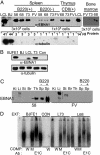Epstein-Barr virus nuclear antigen 1 does not induce lymphoma in transgenic FVB mice
- PMID: 15640350
- PMCID: PMC545574
- DOI: 10.1073/pnas.0408774102
Epstein-Barr virus nuclear antigen 1 does not induce lymphoma in transgenic FVB mice
Abstract
The lymphoma-inducing potential of Ig heavy-chain enhancer- and promoter-regulated Epstein-Barr virus (EBV) nuclear antigen 1 (EBNA1) was evaluated in three transgenic FVB mouse lineages. EBNA1 was expressed at a higher level in transgenic B220(+) splenocytes than in EBV-infected lymphoblastoid cell lines. EBNA1 was also expressed in B220(-) transgenic splenocytes and thymocytes. Before killing and assessments at 18-26 months, EBNA1-transgenic mice did not differ from control mice in mortality. At 18-26 months EBNA1-transgenic mice did not differ from littermate control in ultimate body weight, in spleen size or weight, in lymph node, kidney, liver, or spleen histology, in splenocyte fractions positive for cluster of differentiation (CD)3epsilon, CD4, CD8, CD62L, B220, CD5, IgM, IgD, MHC class II, CD11b, or CD25, or in serum IgM, IgG, or total Ig levels. Lymphomas were not found in spleens or other organs of 18- to 26-month-old EBNA1-transgenic (n=86) or control (n=45) FVB mice. EBNA1-transgenic lineages had a higher pulmonary adenoma prevalence than did littermate controls (39% versus 7%). However, the adenoma prevalence was not higher in EBNA1-transgenic mice than has been described for FVB mice, and EBNA1 was not expressed in normal pulmonary epithelia or adenomas.
Figures




References
-
- Kieff, E. & Rickinson, A. B. (2001) in Fields Virology, ed. Howley, P. M. (Lippincott, Philadelphia), Vol. 2, pp. 2511-2574.
-
- Rickinson, A. B. & Kieff, E. (2001) in Fields Virology, ed. Howely, P. M. (Lippincott, Philadelphia), Vol. 2, pp. 2575-2628.
-
- Kuppers, R. (2003) Nat. Rev. Immunol. 3, 801-812. - PubMed
Publication types
MeSH terms
Substances
Grants and funding
LinkOut - more resources
Full Text Sources
Medical
Molecular Biology Databases
Research Materials

